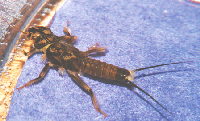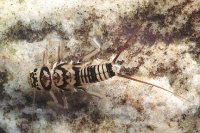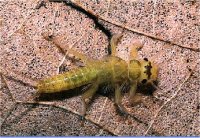PLECOPTERA (STONES - PERLE - SALMONFLIES)


Here is the third part on entomology. We will talk about stones.
Définition: Plecoptera: Greek word: (pleco) folded: (ptera) with wings
Number of families and species in North America - 9 families et 578 species. Their size can vary from 5mm to 3.5 cm.
HISTORY:
Like the ephemeportera, plecoptera have an incomplete life cycle, meaning that they have a 3 stage development. They lay apprx. 1,000 eggs that will hatch in 3 to 4 weeks and those nymphs will take 10 to 11 months before becoming adults. Some species will take some 2 to 3 years for their development.
Stones generaly have 1 generation per year while some species have 2. They crawl out of the river to land on a rock or broken tree on the edge of the river. You will often see their "skins" on top of submerged rocks. The adult live about 7 - 28 days.
They will hatch in spring and summer. Some will hatch in the fall and winter. The eggs of winter stones will incubate for at least 3 to 6 months.
HABITAT AND HABITS:
They have an important need for clean, fresh water that is well oxigenated. They are very sensitive to polution. Their presence show a great quality of water. They never stray to far from their place of birth and rarely take to the wing. They are shy and subtle prefer to hide in the under brush or the surrounding vegetation.
IDENTIFICATION
Stones have two tails. If they try to swimm, they will do it side to side using they legs.
Les Stones ont deux queues. Si elles essaient de nager il le font en mouvements de coté à coté en utilisant leurs pattes.
Généralement elles rampent sur le fonds de la rivière. Ils y a 8 groupes qui ont de l'intéret pour le moucheux. L'identification est basé sur la location de leurs branchies, leurs forme et principalement leurs couleurs.
Early Brown Stones

Golden Stones




Yellow Stones

CHARTE D'ECLOSIONS (approximative):
| Nom Commun |
Emergence |
Hameçon |
| Little Black Stonefly |
Fin Février / Début Mars |
#16 |
| Early Brown Stonefly |
Mi-Mars |
#14 |
| Great Brown Stonefly |
Mi-Avril |
#12 |
| Light Stonefly |
Début Mai |
#14 |
| Eastern Salmonfly |
Début Juin |
#4-8 4x long |
| Great Brown Stonefly |
Début Juin |
#6-18 4x long |
| Willowfly, Big Golden Stone |
Début Juin |
#10 4x long |
| Yellow Sally |
Début Juin |
#14 |
| Little Green Stonefly |
Début Juin |
#16 |
| Great Stonefly |
Début Juin |
#10 |
| Great Brown Stonefly |
Mi-Juin |
#12 |
FISHING:
The important stage for the flyfisher is the nymph. The adult rarely flies, so not very important. But we have some paterns that are fished dry with great succes like the "Yellow Stimulator" and The "Yellow Sally"
The nymph of the stones live at the bottom of the river, which means that your imitations will have to be heavy to be able to hit bottom. Weighted flies, sinking leaders and sinking tip fly lines should be used.
Stones crawl out of the water and you will never see one swim to the surface like the mayflies and caddises. You imitations will have to be at the bottom.
Use a long rod (9'+) so you can reach and guide your stone imitation to likely spots which would be out of reach with a shorter rod. Cast upstream at 45° at about 20' from you adding 5 feet every 5 cast until you have covered the river in that is in front of you, then move apprx. 15'. Let your fly pass in fron of you while holding your rod high so as to feel the most subtle strike. A low rod will not give you this sensitivity. You will have to use a 10' to 12' sinking leader, with a tippet of 2 to 4 lbs test.
Do not be shy to strike if you think you have a strike, better to strike at nothing than to not strike when a fish is on.
TIPS:
Many flyfishers will tell you about collecting species in the river to copy them at the tying bench. Make sure that the fishing rules of the region you are in do not forbid such practices.
Tight Lines!
Bibliography:
Matching the Hatch, E. Schwiebert
Nymph, E. Schwiebert
|

